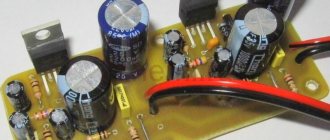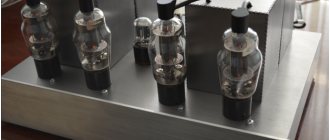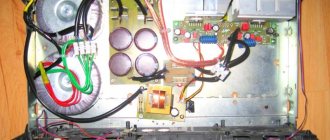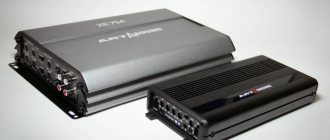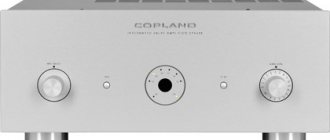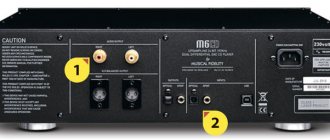Exposure 3010S2 Pre/Stereo Power
- Manufacturer: Exposure Electronics Ltd (UK)
- Made in UK
- www.exposurehifi.com
- Exposure 3010S2 Pre
- Inputs 6 RCA
- Outputs 3 RCA
- Input resistance, kOhm n.d.
- Reproducible range, Hz 1–56,000
- With unevenness, dB -3
- Distortion, % less than 0.01
- Signal-to-noise ratio, dB 96
- Dimensions, mm 440 x 90 x 300
- Weight, kg 7
- price, rub. 40000
- Exposure 3010S2 Stereo Power
- Output power, W per 8 Ohm load 110 per 4 Ohm load n.a.
- Reproducible range, Hz 20–20,000
- With unevenness, dB ±0.5
- Distortion, % 0.015
- Signal-to-noise ratio, dB more than 100
- Dimensions, mm 440 x 115 x 300
- Weight, kg 12
- price, rub. 48000
The British brand Exposure cannot be considered one of the popular hi-fi brands, but it has a very high reputation among a narrow circle of admirers.
The company was founded back in 1978 by John Farlow, an engineer who has long been involved in the development of studio and concert equipment for such famous rock bands as Pink Floyd, Supertramp, The Who, Rolling Stones and Led Zeppelin. Having switched to Hi-Fi, John never turned into a prudent and enterprising businessman, but remained primarily an engineer. Moreover, in his work he continues to adhere to time-tested conservative decisions. You won’t find any radical innovations in his amplifiers—Farlow achieves ideal sound through a meticulous selection of elements and careful optimization of the audio path and power systems. He does not complicate the technique and does not skimp on trifles. So it's not for nothing that Exposure is said to be equipment where every pound invested is justified. The preamplifier and stereo amplifier from the 3010S2 line fit this description perfectly. Externally, nothing fantastic - two identical buildings with flat aluminum facades. The circuit is very simple and logical: switching on a relay, a volume potentiometer with a drive for the remote control, a simple transistor stage in class A, from which the signal is sent to the power amplifier. For an additional fee, one of the linear inputs can be equipped with an RIAA corrector. Note: this device is identical in design to the integral 3010S2 in terms of the preliminary section. Now let’s move on to Stereo Power and see that its circuit on high-speed bipolar transistors is no different from that used in the mentioned integrated circuit! A reasonable question arises: does it even make sense to buy essentially the same amplifier, only “packaged” in two boxes and at a higher price? Eat. It's all about divided nutrition. Inside the pre you will see a very massive toroidal transformer with an impressive block of buffer capacities. And inside the terminal there is already its own power supply system, optimized for high current output. It’s not for nothing that the company itself recommends the 3010S2 Stereo Power for those cases when you need an amplifier to work with a heavy, complex load.
How good the American couple was at constructing sound space, but the British one is even better! The scene is hyper-realistic: the depth is expressive, the geometry is absolutely correct, clear imagery is preserved not only in the center, but also at the edges. Not a single sound is jammed in the speakers, and the scale of the sources is not distorted. The first stereo recordings of CCR or The Beatles, where instruments and vocals were primitively divided into left and right channels, especially benefit from this - they simply come to life.
For Exposure there is no such thing as a defective recording; the musical essence is extracted from any soundtrack. You even enjoy listening to what was once recorded on creaky compact cassettes and then digitized into mp3. The tip has crushing dynamics throughout the entire band, but does not turn it into aggression. The drums sound sharp and not flat. There are no painful resonances on powerful bass guitar passages - a clear, consistent relief is preserved. All bass structures are perfectly separated and do not interfere with each other. Almost perfect clarity reigns further down the spectrum. In the HF/LF transition region there is no hint of mutual modulation; the main and high middle registers are clean and tonally saturated. Even what is sometimes not noticeable at all is conveyed naturally and beautifully - the instant reverberation responses that arise in small studios.
The 3010S2 end unit, while not the most powerful in our review, is well suited for listening at high volumes. On the one hand, it is free of the “first watt” problem, but even at power ratings it retains an excellent sound form and does not cause headaches.
The only caveat concerns the upper case. The device itself is not as loud as its competitors. However, this does not mean that it is less detailed. If your acoustics give a slight rise at the very edge of the HF, you won’t even notice the lack of “air”.
Distortion spectrum Exposure 3010S2 Stereo Power
The picture shown in the graph was obtained at a power of 10 W. All harmonics are visible in the spectrum, up to the 20th, with the even ones being suppressed more strongly than the odd ones.
High-order components can give the sound some harshness and a “transistor” coloration, so for an amplifier it is better to choose acoustics with soft silk tweeters.
Dependence of SOI on output power of Exposure 3010S2 Stereo Power
The amplifier has a fairly high level of distortion at powers up to 2 W. In this area, the SOI drops almost 10 times, then begins to increase again. When switching to a 4-ohm load, the power increases by 1.90 times (from 100 to 190 W, respectively), which indicates a very high power reserve, allowing you to work with “heavy” low-impedance acoustics.
PLEASED
Excellent dynamics across the entire frequency range. Exemplary spatial legibility and imagery. Good harmonic resolution in low and midrange registers.
DISAPPOINTED
The nature of the HF transmission is peculiar - metal trebles may seem rough, and noise sibilants may seem slightly muffled.
amplifiers 51150 - 138000 rub.
- Cary CPA 1/Cary CAA 1 RUR 138,000
- Exposure 3010S2 Pre/Stereo Power RUB 88,000
- NuForce P-8S/ST-8.5V2 RUR 51,150
share
Tags: ExposureExpert's Choice
Exposure 3010 - English output
English sound. English quality. Surely you have heard such phrases along with the concepts of American or Japanese sound. But we’ll look into the differences some other time, but for now let’s focus on England and specifically the Exposure 3010 power amplifier.
The former owner of this unit said about its sound that it is a classic modern English sound - a lot of air, high detail and musicality. He also assured, as the owner of both the power generator and the integrated circuit (they can be used for biamping together), that the power generator is still the same 3010 integrated circuit from which everything unnecessary was thrown out for the shortest signal path. Those. we can assume that the reviews that described the 3010 integrated circuit and the power supply should be quite similar, we’ll see.
I saw reviews online about this or the next version of the model:
1. Rock sounds excellent, metal sounds good, calm classical sounds good, highly emotional - mediocre.
2. The sound is dense and at the same time very transparent, the amplifier has warmth and musicality. I listened to other amplifiers with a dry analytical sound, maybe they are more reliable, but I didn’t like it.
3. Plays well at low volume, the stage is very wide but not deep. The sound is enveloping and very smooth! What I personally don’t like is that with this kind of music delivery you can easily fall asleep, especially when you pick up the speakers. The bass is very balanced where you expect thunderclaps, this does not happen, the mids are gorgeous, very smooth with excellent resolution!!! The same cannot be said about tall ones. The amplifier plays best with bookshelf speakers and floor-standing speakers, the sound becomes a little irritating to the ear. proven over the years!! The speakers were different, the audio monitor was silver...they gave me an Icon. etc. etc. I liked the Yamaha the most, the sound was very musical. but everything else suffered!!! direct comparison with Onkyo amplifiers and especially Yamaha from Exposure in the latter the overall transparency and sound resolution was much lower and very noticeable! I really didn’t like the stage that the amplifier builds. The depth of the stage is completely absent. But the width, on the contrary, is large. The sound is very forward! but at the same time, the transparency of the sound is low, the instruments are always tied to the speakers. And changing the signal source will not help here!!! and the correct selection of acoustics will help increase transparency and resolution without compromising musicality!!! In the end, what I want to say is if you like this amplifier! you will always miss transparency, clarity and precision!!! but the musicality will be at its best!!! By the way, the amplifier plays heavy music amazingly without any mess and with good dynamics!!! But blues jazz spoils the stage and, most importantly, the timbres of the instruments!!! The tonal balance is not the best!!
Salon Audio Video magazine published the following summary of the Exposure 3010 S2:
During listening, the device demonstrated a fairly smooth sound with a slight emphasis on the mid-bass region. However, overall it is attractive, especially with its refined mids and skillfully correct top end. The vocal spectrum is presented in all its glory - here you can find exquisite timbres and the highest detail. The attack seemed somewhat smoothed out - the percussion instruments (especially with their abundance in the composition) somewhat lose their pressure and rhythm. The space can be given a solid A. The images are material, and the scene itself has a certain perspective. There is absolutely no void between the acoustics.
But before we start discussing the validity of all the above opinions, let's look at the Exposure 3010 powerhouse itself from a visual delight perspective.
ENGLISH QUALITY
Yes, sir, this is an English quality, I think it’s worth considering what it is.
The first impression is unfortunately not for the better. This is a fairly standard DIY metal box with an aluminum front, evoking that same strong homemade feeling.
I have seen a lot of such cases, even in better quality and design, on Chinese aliexpress, and even much better.
Just look at the appearance of DartZeel, for example.
Or the Hood SA1969 clone looks very organic.
I'm not even talking about the beautiful visually original Chinese amplifiers like Yaqin MC-100, etc.
ERGONOMICS
Let's try to understand what the ergonomics of a power amplifier may be. In practice, it is very convenient, but not necessary if the power has volume control. Yes, you are a purist, a real fierce audiophile and an extra RG will worsen the heavenly purity of the sound - I agree, but actually not in the case of Exposure, as discussed below, and secondly, it doesn’t bother many eminent audio giants to install a Volume Control and get an excellent class sound, for example Yamaha P2200/P2100/PC2002, Onkyo M-506, M-509, Parasound A23, etc. I would even say that the vast majority of power units that came into my hands (Onkyo, Yamaha, Technics, Pioneer...) had volume controls.
Onkyo M-509
This is not a drawback for the powerhouse, it is just a noted fact that can reduce the ergonomics of the device. There are also more tangible disadvantages in ergonomics, in my opinion.
But first, let me explain - ergonomics is not a verdict that the device is bad, this is generally not a detail that is so important for the sound, these are only those moments that personally could make life with this device more convenient for me. If the device sounds like a god, then it will become indifferent to what it looks like and what else it needs to work (prefix, cable, etc.).
My second minus is for the cable. Firstly, only unbalanced switching, but in its price niche (by the way, the modern price is 112,000 rubles or $1800!) The presence of XLR is rare, but it does happen (Parasound A23). Secondly, in point two, I will note the connection of speaker wires only with bananas.
It seems like a small thing, but this immediately imposes huge restrictions on most commutations.
For example, okay, I won’t be able to use my favorite thick biwiring cables, which I attach to other amplifiers using the direct clamp method, I will use a Nordost Flatline Gold MKII cable with banana connectors, although I’m far from a fan of it. But problem number 2 immediately arises - how can I connect such a cable to an excellent acoustic system with giant beryllium midrange and high-frequency speakers - Yamaha NS-1000M, if only a bare wire can be connected there?
Therefore, I will have to abandon the use of such reference monitor speakers as the Yamaha NS-1000M with the Exposure 3010.
And also refuse the possibility of using the Diatone DS-77Z, because although I can hardly insert a banana into its connectors, if I squeeze it, I will most likely destroy the banana (they are very thorny in Nordost).
So, for me this is certainly not a big problem, I can use the Hi-End bookshelf speakers Onkyo D-302e or Onkyo D-500 II Liverpool, but this is definitely a problem with the ergonomics of the Exposure 3010.
There are also oddities in the circuit design. In an attempt to make the signal path as transparent as possible, the amplifier lacks a soft start and when switching on and off you will hear an unpleasant click in the speakers - perhaps the English mentality at work.
SOUND
I've had the Exposure 3010 for a few days now, but it was extremely difficult to judge its sound. Of course, if everything was in key, I listened, was shocked and gasped - it would be simple. But it’s difficult to explain that a device for 1200 pounds or 1700-1800 dollars sounds extremely unconvincing.
It was also difficult for reviewers and Audio Video Salon to praise the advertising apparatus, considering that everything was paid for.
We’ll probably start with their resume for Exposure 3010. To avoid any misunderstandings, the magazine reviews the next model (the same device released later) - Exposure 3010 S2. But, sorry, I can’t believe that he has become so much better.
So, let's read it again.
During listening, the device demonstrated a fairly smooth sound with a slight emphasis on the mid-bass region.
The sound is certainly smooth, but I didn’t notice any emphasis on the midbass.
However, overall it is attractive, especially with its refined mids and skillfully correct top end.
There are no refined midrange frequencies in the Exposure 3010, since the device produces sound rather muddy. In light of this, I fully admit that a skillfully correct top is called the absence of sibilance or roughness in the sound, due to smoothing by insufficient musical resolution.
The vocal spectrum is presented in all its glory - here you can find exquisite timbres and the highest detail.
Sorry, here it was necessary to earn bread for advertising to the author of the magazine. High musical resolution is not the strong point of the Exposure 3010. It can catch you precisely because of its haze, the background presentation of music that does not cause fatigue, you can also call it “musicality,” but by this term I mean something else, not haze.
Exposure 3010 inside
The attack seemed somewhat smoothed out - the percussion instruments (especially with their abundance in the composition) somewhat lose their pressure and rhythm.
It’s difficult to draw a conclusion with the attack, because due to the cloudiness of the sound, all sound events are presented somewhat blurred.
The space can be given a solid A. The images are material, and the scene itself has a certain perspective. There is absolutely no void between the acoustics.
If there is no emptiness between the speakers, then excuse me, then why should the sounds be located at different distances, that is, there is actually no scene there, right?
Exposure 3010 also has a second layer of boards
Okay, let's leave this fake magazine review alone - this is an example when you don't need to believe everything that they write. But there are honest people who really write as it is.
Yes, there are such people, I will once again give a review from a person who described exactly what Exposure 3010 actually sounds like, sorry, copy-paste, but this time with my comments:
Plays well at low volume
It is worth noting that in general the volume of this powerhouse is quite low. Officially stated is 200 watts per channel at 4 ohms. But, guys and girls, there are always nuances. Namely, 200 watts dynamic at 4 ohms. those. without dynamic they would have drawn 80-120 watts, but at 8 Ohms - its real ones would have been 45-60 watts. This is what it sounds like. In addition, modern speakers with a resistance of 4 ohms most often have far from outstanding sensitivity. For example, the Onkyo D-302e I used for listening is only 83 dB. Of course, I also tried it on a lighter acoustics with greater sensitivity - Onkyo D-500 II Liverpool. When listening, I adjusted the volume using the Inntak Saber ES9018 2x Muses8920 + 2xAD797 +2xR-Core DAC, where there is a digital control (reduces the bit rate), and so that this does not affect the signal quality, I use Hi-RES audio with parameters 96 or 192 kHz 24 bit.
The stage is very wide but not deep.
Yes, the amplifier has a wide stereo panorama, but it does not have a stage, there is no separation at all.
The sound is enveloping and very smooth! What I personally don’t like is that with this kind of music delivery you can easily fall asleep, especially when you pick up the speakers.
The presentation is really nicely smooth, very reminiscent of vinyl or a tube amp. You can start listening to a song and really think while listening to the background sound, and by the end of the song you will wake up from your thoughts without hearing anything.
The bass is very balanced where you expect thunderclaps, this does not happen, the mids are gorgeous, very smooth with excellent resolution!!! The same cannot be said about tall ones.
The Exposure 3010 amplifier has a very unique concept of resolution. After really high-end devices, everything is very blurred, emotions are muted, it would seem that this is the verdict, but at the same time the device can unexpectedly produce a sharp, detailed sound in the middle or high register. But I can say for sure that if it sounded convincing on the Exposure 3010, then on higher-level devices this sound would crawl into your soul and gut it.
The amplifier plays best with bookshelf speakers and floor-standing speakers, the sound becomes a little irritating to the ear. proven over the years!! The speakers were different, the audio monitor was silver...they gave me an Icon. etc
As I noted above, I was not able to test the amplifier with floor-standing speakers due to the device’s ergonomic limitations.
I liked the Yamaha the most, the sound was very musical. But everything else suffered!!! direct comparison with Onkyo amplifiers and especially Yamaha from Exposure in the latter the overall transparency and sound resolution was much lower and very noticeable!
Yes, compared to Yamaha (p2200, p2100, ax-2000, ax-1) or Onkyo (919, 506), the music resolution and transparency of the Exposure 3010 is much lower.
I really didn’t like the stage that the amplifier builds. The depth of the stage is completely absent. But the width, on the contrary, is large. The sound is very forward!
As I described above, there is a stereo panorama, but there is no scene.
but at the same time, the transparency of the sound is low, the instruments are always tied to the speakers.
This is due to the general dullness of the sound.
And changing the signal source will not help here!!! and the correct selection of acoustics will help increase transparency and resolution without compromising musicality!!! In the end, what I want to say is if you like this amplifier! you will always miss transparency, clarity and precision!!!
Gold words.
but the musicality will be at its best!!!
I agree, but with reservations, which are discussed below.
By the way, the amplifier plays heavy music amazingly without any mess and with good dynamics!!! But blues jazz spoils the stage and, most importantly, the timbres of the instruments!!! The tonal balance is not the best!!
You have received preliminary food for thought, and now my personal impressions of the Exposure 3010 power amplifier.
The Exposure 3010 amplifier does not focus listening on details, so everyone correctly notes that it is truly musical, but with one caveat regarding the quality of the recordings.
If on the Yamaha P2200, Onkyo A-919 and even on the Parasound A23 I can listen to any recordings at all and they will sound amazing, three-dimensional and extremely detailed, then the Exposure 3010 is very selective (due to weak musical resolution) to recordings, it can only handle with recordings of outstanding quality, so to speak - audiophile. If the recording is a little more complicated, then the device immediately gives in due to its turbidity. That's why with Exposure 3010 you immediately have "no-sound" recordings and "well-recorded" recordings.
The device is also critical to the number of simultaneously sounding instruments; on rock (it would seem that England, old rock should show it like no one else) it simply turns loud moments into mush and screaming.
By bass. In my opinion, the bass control does not stand up to criticism - it is something amorphously buzzing. You know, in terms of its sound, the Exposure 3010 simply reminded me of a tube amplifier on the EL34 with 100% approximation. The same unclear, but “musical” sound, the same amorphous rollicking poorly controlled bass, etc.
Therefore, the device will certainly have fans committed to this type of sound; fortunately or unfortunately, everyone will decide for themselves, I am on the opposite pole from such a sound.
Exposure 3010 does not and cannot have microdynamics due to the smooth sound delivery.
I would write that the sound is like being under a swaddle or coming from under a blanket, but it’s funny that this is not the case. In general, everything is presented rather unclearly, smoothed out in all aspects, but this does not prevent one from unexpectedly showing sharp high sounds or some other bright sounds quite clearly.
Regarding the price of the remake at 112,000 rubles, I sympathize if you bought one in a store without wiretapping. On the used market, of course, the situation is much better; these amplifiers are no longer judged by magazine advertising, but by their actual sound capabilities.
Once again I’ll summarize the pros and cons of the Exposure 3010 regarding sound.
pros
Musical, relaxed presentation. Nice to listen to in the background.
Wide stereo panorama
Minuses
Low music resolution
Simultaneously many sounding instruments in rock (and not only) at high volume = mess
Boomy, poorly controlled bass
Plays well only “audiophile” recordings, trios or in chamber compositions
Before moving on to the final part, I’ll answer what the Exposure 3010 amplifier really lacks in the first place.
It lacks high musical resolution, as a result of which it lacks piercing transparency, the smoothness of micro-details and transients does not allow a scene to appear, the echeloning of instruments in depth, and not just in width, does not allow micro-dynamics to appear. All we can expect from the Exposure 3010 is smooth sound in small groups, wide stereo panorama and some form of macrodynamics.
Next, I invite you to watch the video recording of the Exposure 3010 sound demonstration.
In the demo, I tried to show not only the excellent jazz recordings that start the video with the Exposure 3010, but also the usual, “everyday” ones that you would want to listen to (ABBA, Queen), with which the amplifier feels completely insecure.
In the first half of the video, the demonstration is carried out mainly on Onkyo D-302e half-speaker systems (2006, $1600 euros, 4 Ohm, 83 dB). From the second half of the video (CC Ketch), I use the Onkyo D-500 II Liverpool speakers (1990, 86,000 yen, 6 Ohm, 90 dB), which are simpler in class, but brighter and lighter in load and sensitivity.
On ABBA and Queen, one can clearly see the inability not to dump everything into a mess, to leave the sound with the necessary detail when the intensity of passions increases and tends to its extreme. Heavy metal played quite nicely.
And I almost forgot, at the end of the video there is a bonus in the form of a comparison with the sound of the composition of the Doors group and the powerful Parasound A23, which already has everything like an adult, and balanced inputs, and ergonomic terminals for speakers and high musical resolution.
VIDEO
ENGLISH SOUND
So what is the English sound? It is naive and completely stupid to draw conclusions based on listening to one, albeit expensive ($1700) model of an English power amplifier. So far, for me personally, the result is not convincing - the design is primitive in the bad sense of the word, the sound is unclear, fortunately not dull, controversial ergonomic solutions are not something that can sell itself today. Although advertising can do everything + lack of information - that’s all + rumors and “legends” and sometimes sells the strangest products. However, what is bad for a well-fed audiophile is a revelation for a novice music lover; everything in the world is relative.
And agree to always be curious to touch a musical-sounding amplifier from the most foggy England with sirs and lords.
